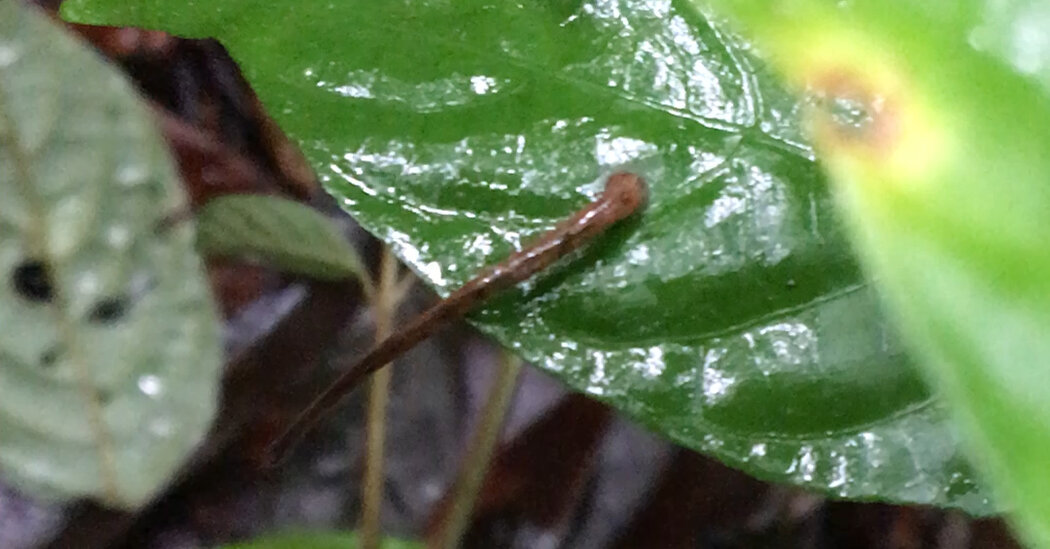Land-dwelling leeches can seem like placid creatures. But when they’re on the hunt for blood, look out.
An appetite for blood may have provoked acts of startling athleticism, documented in a pair of videos released Thursday by two scientists alongside a study in the journal Biotropica. In each, a brown pillar of flesh and muscle, standing atop a green leaf, waves back and forth on its quest for blood. Then, it coils itself into a comma, bunching up its lower half. Finally, the leech leaps, flying through the air with a kind of wild abandon.
Lean closer, cup your ear: You can almost imagine you hear a tiny “Yahooooooo!”
Mai Fahmy, currently a postdoctoral researcher at Fordham University and a visiting scientist at the American Museum of Natural History, took the first video in Madagascar in 2017. At the time, she had never heard of the long-running debate among scientists about whether leeches could jump.
“It takes a few years of leech study before you learn about the great debate,” reflected Michael Tessler, a specialist in leech biology at Medgar Evers College of the City University of New York and a research associate at the natural history museum. He is Dr. Fahmy’s co-author.
Her 10 second clip, taken on a whim, turned out to be the first recorded visual evidence known to science of leeches jumping.
There had been other claims of leaping leeches. In 1881, the biologist Ernst Haeckel visited Sri Lanka and described the behavior: Not only did they crawl on the ground, he wrote, but they could also “spring to reach their victim.”
Scientists have long been skeptical of such anecdotal evidence. In tropical forests, it is common to discover leeches unexpectedly high up on one’s body, on the arms, neck, shoulder, or even in one’s eyes. Were observers finding leeches that had dropped from vegetation and just assuming that the creatures could jump?
After Dr. Fahmy shared her first springing leech video with other people, most recognized the jump immediately. When she and Dr. Tessler analyzed the leech’s movement, they identified that it made a curling motion similar to the move a cobra makes before it strikes. The gesture seems to be a gathering of energy, a preparation for what comes next — flight, and an uncoordinated, almost slapstick landing.
In fact, they discovered, this particular sequence of movements — curl up, jump, finish with a belly flop — is not unusual among other worm-shaped organisms that jump, including caterpillars and fly larvae.
The way the leech plops onto the forest floor in the 2017 video, with very little obvious control of its landing, seems to be common among these creatures. It’s possible, Dr. Tessler said, that because larvae, caterpillars and leeches are very light, they don’t need a precise landing to avoid injury.
In 2023, Dr. Fahmy was again in Madagascar, and she took out her phone to film a pair of leeches on a leaf. Within seconds, she was seeing the same move again — one of the leeches bunched itself up and took to the air. She and Dr. Tessler identified the leech species in both videos as Chtonobdella fallax, a member of a larger family also found in the Seychelles, Southeast Asia and the South Pacific islands.
That Dr. Fahmy was able to capture these videos without much planning suggests that jumping may be regular behavior for some leeches. The researchers hope that other people may go forth and film more acrobatic blood suckers. It may be that one of the problems holding up the identification of leech leaping for all these years was the absence of humans with cameras.
Dr. Fahmy and Dr. Tessler note, however, that the presence of a big, warm bag of blood nearby can get leeches pretty riled up. They will start the leech version of running, a furious inchworming along, to try to get closer to you.
“That can be pretty frantic,” said Dr. Fahmy. “And when there are a lot of leeches, it can be kind of overwhelming in the field to notice that you are being pursued so intensely by so many little guys.”
“They book it,” Dr. Tessler added. “It can be pretty wild.”
